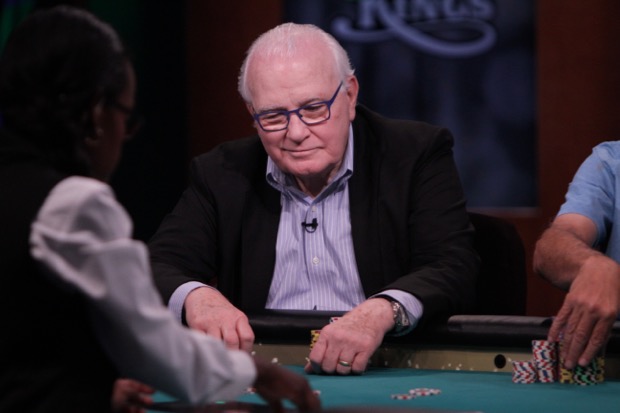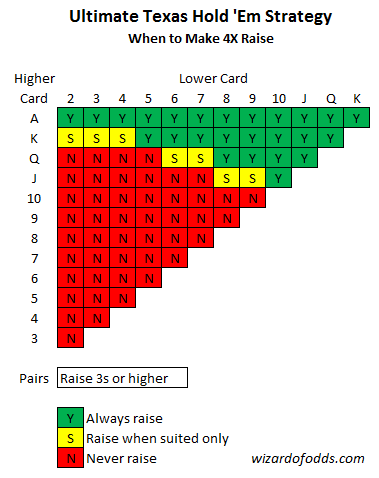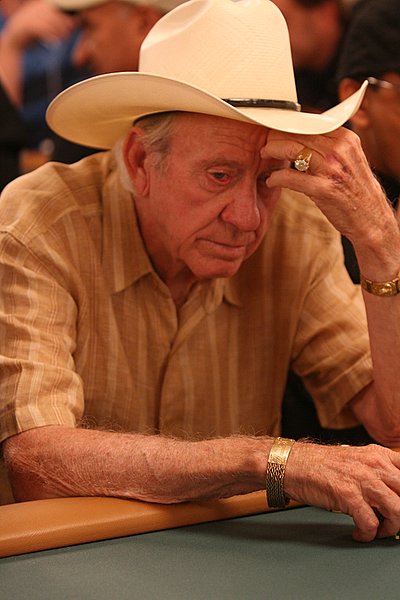Texas Holdem Tournament Strategy
Since the World Series of Poker is taking place now, I thought a column about poker tourney strategy was in order. Enjoy!
Most Texas Hold’em strategies are going to focus on specific hand situations. These can be helpful to your game in poker tournaments because you will see how you would have played it, as well as how you should have played it. You won’t find much information on Texas Hold’em. To win at Texas Hold’em, the best route is to use several strategies to give you the upper hand. Once you know how to play Texas Hold’em, you can begin to employ strategies like knowing when you have a hand to fold on or bet big with, reading your opponents, and playing the odds to win.
Poker tournament tips is, apparently, a pretty common search term on Google. I assume the searchers are looking for a quick checklist to go over before playing a tournament, and not advice on how much to tip the dealers after a big win. When I searched “poker tournament tips” for myself, none of the results were particularly fruitful, with most info being wrong or outdated. Tournament strategy for Texas holdem involves consideration of competition with certain prize draw. Select whether it is going to be daily, weekly, monthly and annual tournament. Advanced approach of Texas holdem tournament strategy is all about finding out the level of skills that opponents have. But, you can change all that with a solid Texas Hold'em Tournament Strategy plan. And, of course, you will need to be able to make that plan work to win. In this guide, we'll show you how to become a tough tournament player. No one will mistake your buy-in as a stepping stone to their success, ever again.
It seems that everybody plays in no-limit Texas holdem tournaments. Of course the exploding television coverage brings new players into the no limit texas holdem game daily, which leads to better ratings and even more poker tournaments on television. When will it end? Not anytime soon. With all these new players, I am often asked about how to play tournaments correctly.
Texas Holdem Tournaments
To determine correct Texas holdem tournament strategy you need to start with some self-analysis. You have to ask yourself these questions:
- What is my ultimate goal in the poker tournament?
- Will I be satisfied if I place in the money, make the final table or do I have to win to be happy?
- Am I willing to take the chances of exiting early to put me in a winning position by going all-in?
- Casino Action
100% Up To €/$150
Rating
3.9/54.3/53.3/54.2/53.9/5
- Superior Casino
250% Up To $/AU$/€2500
Rating
4.2/54.1/54.2/54.2/5
- King Billy Casino
100% Up To €/$200 + 200 Casino Spins
Rating
4.1/54.3/53.9/54.1/5
If you have just gotten started playing tournaments, you should aim to place in the money. Obviously, all of us always want to win, but a Texas holdem strategy designed to win in any case means you have to take many calculated risks with little or no advantage. You need to gather up a large chip stack in order to place high in a tournament.
If your goal is to place as high as you can, hopefully in the money, then you ought to play extremely tight, especially earlyon in the tourney. Just do not enter any pots if you aren’t certain you have the winning hand. Most tournaments structure the blinds so you can go a long time early without playing a hand until the blinds get too big.
The largest difference between a normal ring game and a poker tournament is that once your chips are gone, you are out of the tourney. In a regular ring game you can buy more chips whenever you like. That is what makes tournament strategy different. Some people simply want to place in the money while others play to win. That begs the question: Why doesn’t everyone play to win? Well, it has to do with the variance associated with two different playing styles.
Often players who are playing to win will get their money in with even the slightest advantage, sometimes even though they have only a 52% or 53% chance to win any given hand. If they are lucky, they can accumulate a big stack of chips, which they need in order to win. If you get all of your money in the pot in such marginal situations you run the great risk of busting out of a tourney early.
If you just want to get into the money you need to play much tighter. You need to try to get better odds before you get your money in the pot, many times as high as 80% or 85%. This approach has the problem that the blinds generally eat a large part of your stack between these opportunities.

Texas Holdem Tournament Strategy

The proper strategy to being a successful tournament player likely lies somewhere in between these two styles. As usual, you should try to bet when you are a favorite to win (have the best poker hand), but in tight situations in a tournament it may be better to hold back unless you are getting short stacked. If your stack gets too short you will have to pick a good starting hand and bet all of your chips and hope that nobody else has a better hand.
Early on, before the blinds get too high, I recommend playing very tightly and only entering the pot with your very best poker hands. Should you have the opportunity to get all of your money in with at least one other person, and you have AA, KK or even QQ, - take it! If you can double-up early on in a poker tournament, that not only gives you extra chips, it also can be a tremendous psychological advantage. If you have a tall stack it works for you on a psychological level! As you continue into the tournament, the bigger your stack, the easier you may be able to force your opponents with fewer chips to fold their hands instead of taking a risk with all their chips.
Usually you find no-limit Hold'em poker tournaments to move along pretty fast. We should discuss a few important points here. If you make just one mistake, it can end your tournament. At any time all of your chips can end up in the pot. Therefore it is important to always play just as well as you can.
You have to learn as much about your opponents play as you possibly can. Take your time if you have to and always pay attention. Do your very best not to lose concentration, even for a second.
Good luck in your Texas Hold'em tournament adventures.
Every year the World Series of Poker offers a wide range of variants and game types for poker players. Without question, one of the most popular choices is six-handed no-limit hold’em.
Many are familiar with full-ring NLHE, but the short-handed version brings significant changes to strategy, as WSOP bracelet holder and World Poker Tour champion Taylor Paur explained to us yesterday.
Paur has nearly $3 million in career live tournament earnings, the largest chunk coming from his victory in the most recent WPT Shooting Star in San Jose where he topped a 708-entry field to capture a $1,214,200 first prize. Paur won his WSOP bracelet in 2013, besting 2,071 players in a $1,000 no-limit hold’em event for $340,260.
The 26-year-old poker pro from El Dorado Hills, California also has experienced considerable short-handed success at the WSOP, twice making final tables in six-max events. Paur finished fifth in the $10,000 No-Limit Hold’em Six-Handed Championship in 2011, then took sixth in last year’s $1,500 No-Limit Hold’em Six-Handed event.
With a focus on players who are used to playing full-ring (nine- or ten-handed) NLHE multi-table tournaments, here are Paur’s six tips for those getting started with six-max tournament poker.
1. Overall Adjustments
“Just tighten up,” Paur begins when addressing how to adjust from full-ring to short-handed play. “Try to play solid. You’re better off not playing too many pots, and play the pots you enter to win.”
“That’s much better than trying to get involved in a lot of hands against good players,” he continues. “Just play the hands you play aggressively.”
2. Avoid Overplaying Hands

Many players new to six-max tournaments will overcompensate and feel they need to change their games dramatically from full-ring play. Paur warns inexperienced players against this, noting how in theory you don’t need to alter your game a lot.
Texas Hold Em Strategy
“It is easy to overplay your hands, and a lot of people feel the need to change a lot of stuff when they play six-max,” says Paur. “In this format you just get into a lot more situations postflop where you need to be able to read hands with lesser strength hands, instead of just playing premiums.”
“Inexperienced players get themselves into very big pots they can’t find a way out of,” he continues. “That’s how you see many people bust in the early levels of a six-max tournament, especially the lesser experienced ones.”
Texas Hold'em Tournament Strategy Tips
3. Blind Play
Since the blinds come around more often, adjustments have to be made when you’re playing short-handed. Paur explains how you should be defending your blinds more often and three-bet more, too, because the opening range from every position is a little bit wider.
“It’s up to personal preference whether or not you like to put in more three-bets or calls, and there are lots of different views on that. A lot of these GTO (Game Theory Optimal) guys seem to say that calling everything out of the big blind is the best way to go. I don’t agree with that. I like to mix it up based on how my actions are being perceived by the person I’m up against, [and from that I will decide] whether or not I’m going to three-bet or flat or fold. And, of course, it matters what cards I have.”
Also worth noting is the fact that the small blind presents a completely different situation than does the big blind. As Paur explains, the small blind is his least favorite position, and probably one from which to be extra cautious.
“I don’t mess around in the small blind,” says Paur. “I don’t believe people who mess around from the small blind, and I don’t expect them to believe me. I’m scared of the small blind — it’s like a pet peeve.”
4. Adjusting when Under the Gun
Things start to look up once you’re under the gun, but it’s still not a position from which to go crazy. One important point Paur makes is that those who are new to six-max need to start thinking of the positions at the table in a different way.
“I personally think of under the gun full ring as if it were 6-max, but it’s basically middle position when you’re full ring. My opening range is probably too wide, so I don’t take under the gun as serious as it sounds.”
5. Playing from the Cutoff
Things start to get fun when you’re in the cutoff, where open-raising almost feels mandatory if the right person is sitting to you left.
“A lot of your play in the cutoff depends on who is on the button,” Paur explains. “If it’s someone who’s not going to mess with you, you can treat it as if you are on the button. If it’s someone that’s willing to go to war, you might have to go to war.”
“On the other hand, you might have to tighten up a little bit, but that all depends on who your opponent is, and the flow at the table.”
6. Playing from the Button
The best position in poker — and it really doesn’t matter what format you’re playing — is the button. This is no different in six-max no-limit hold’em, and Paur closes out with some words of wisdom on playing six-handed tournaments from most fun position in poker.
“You can obviously play more hands from the button, just because you always have position and that is very important,” he says. “You have a wider opening range from the button, and you can play more hands.”
There you have it — you no longer have to fear the short-handed action at the WSOP, at your local casino, in your home game, or online. Even when your cash game gets short-handed, you know the approach to take — so don’t panic and start raising from the button!

Want to stay atop all the latest in the poker world? If so, make sure to get PokerNews updates on your social media outlets. Follow us on Twitter and find us on both Facebook and Google+!
Tags
tournament strategysix-max strategyshort-handed strategyno-limit hold’emWorld Series of PokerWorld Poker Tour2015 WSOPTaylor PaurPoker TournamentsRelated Tournaments
World Series of PokerWorld Poker TourRelated Players
Taylor Paur